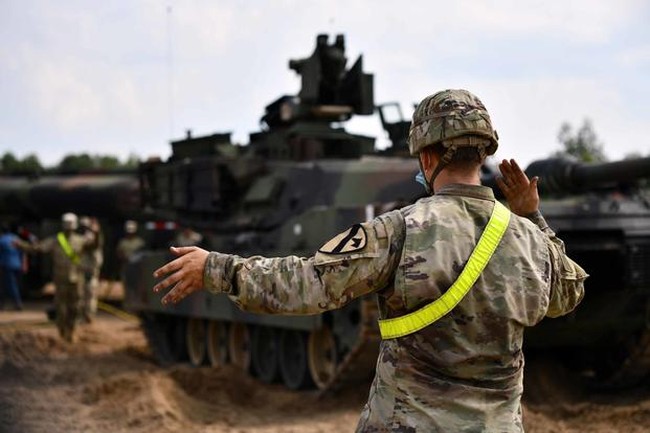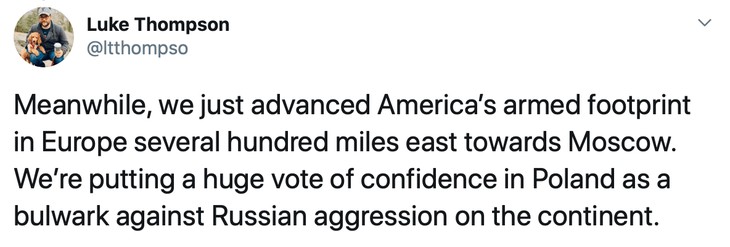For more than four decades, the United States Army’s V Corps — one of the most powerful armored formations ever assembled — stood watch against the Soviet Union on the Fulda Gap, the primary World War II invasion route from East Germany through West Germany to the Rhine.
With the end of the Cold War, a shrunken V Corps remained in Germany through the 1990s with much less to do.
An even smaller V Corps was deactivated in 2013 following a decade of counter-terror service in the Middle East and Afghanistan.
V Corps was reactivated earlier this year as a part of President Donald Trump’s national defense strategy, to be headquartered at Fort Knox in Kentucky.
On Friday we learned that V Corps will be moving overseas again — this time to Poland.
While that might seem like dry news, boring even, V Corps finding a new home in Poland is a very big deal.
While much has been made by the mainstream media — almost all of it negative — about President Trump’s decision in July to remove thousands of American troops from Germany, less has been said about where they’ll end up.
Nearly 12,000 troops will be redeployed from Germany, reducing the American presence there by about one third. Of those being redeployed, around half of them will end up in other NATO ally nations, including Poland and the Baltic States.
A headquarters like the newly reestablished V Corps is a big deal in and of itself, providing “command and control focused on synchronizing U.S. Army, allied, and partner nation tactical formations,” according to Army Chief of Staff Gen. James McConville. Placing V Corps in Poland send a serious message about serious intent.
In effect, NATO’s front line defenses are moving to the east. Or as Luke Thompson noted last week:
If Trump is a Putin stooge, he’s the worst Putin stooge ever.
I was long a critic of NATO expansion into the former Warsaw Pact countries.
I was especially critical of NATO including the Baltic countries — Lithuania, Latvia, and Estonia — that had once been illegally annexed by Soviet dictator Joseph Stalin under the terms of the odious Molotov-Ribbentrop Pact with Nazi Germany.
In fact, I was long a critic of NATO’s continued existence.

My thinking at the time the Soviet Union self-dissolved in 1991 was as relieved and happy as it was simple: NATO should have thrown itself one hell of a victory party, and then dissolved itself, too.
That isn’t to say we’d have cut all military relations with our old allies in Western Europe, or that we wouldn’t have made new friendships with our former Warsaw Pact foes in Eastern Europe.
Far from it.
Also for our VIPs: Hiroshima, Nagasaki, and the Myth of American Institutional Racism
We would and could have maintained a sort-of entente cordiale with Europe — less than allies, but more than acquaintances. In addition, we could have helped to re-equip and re-train former Pact nations like Poland and Romania, but without the added risks (to us) and threat (to Russia) of entangling alliances.
Keeping NATO in existence allowed its once most-powerful European member, Germany, to believe they were no longer responsible for their own defense. As a result, the German military these days is barely big enough or even well-trained enough to put on a decent parade.
After the horrors of the 20th century, it seems impossible that we’d find ourselves in a place complaining that the German military is too weak, and yet here we are.
Expanding NATO right up to (and in the case of the Baltic States, inside) the borders of the old Soviet Union accomplished little other than to feed historical Russian paranoia about Western intentions. And after one invasion by Napoleon and two by the Germans, who could blame them? Including Estonia in NATO brought the alliance’s borders to within spitting distance of Leningrad (now St. Petersburg once more).
Worse, NATO expansion greatly increased the alliance’s military responsibilities at a time when NATO’s military forces were getting RIFfed into shadows of their former selves.
Better then to savor victory in the Cold War without having to fight WWIII, and bring our boys home.
But that was my thinking in the 1990s and early 2000s.
The rise of Vladimir Putin to power — based at least in small part on Russian fears over NATO expansion — changed all that.
One simply doesn’t abandon a defensive alliance in the face of a rising, expansionist power. While Putin’s Russia is only arguably rising, its aggression toward neighboring countries in the “near abroad” like Ukraine and Georgia show that there’s never been a better time in the post-Cold War era to strengthen NATO.
President Trump has been trying to do just that even before he entered office, using threats and bluster to try and get Germany to take seriously their own defense for a change.
Berlin — increasingly in thrall to Moscow for its energy needs — would hear none of it.
Having failed at waking up Germany, Trump is trying something new: taking American troops and American dollars away from wealthy, negligent Germany, and redirecting them to poorer but more serious countries like Poland.
Trump’s move is deliciously ironic. It was 100 years ago this month that nascent Poland, recently reborn from the ashes of World War One, saved Europe from Soviet domination by winning the little-known Polish-Soviet War of 1919-20.
Since admission to NATO in 1999, Poland has done much to train and equip its military up to Western standards, including adopting American gear like the F-16 Fighting Falcon.
Poland deserves an American presence far more than Germany has in recent years, and reinstating V Corps on Polish soil is a testament to serious decision-making by President Trump and his national defense team.











